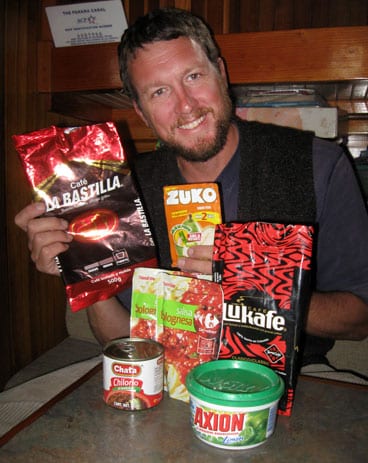
Ben Zartman
I mentioned recently in an article I wrote how nice it was to return to U.S. waters after a lengthy absence and find all the goodies that had been unavailable—or, at best, hard to get—as we cruised along the Pacific and Caribbean coasts of Central America on board Ganymede, our Cape George 31. Bagels, decent hot dogs, peanut butter, engine parts—the list goes on. But even back here, now, in this land so distinguished by its embarrassment of choices, I find myself searching in vain down grocery-store aisles for certain lifesaving products for which we developed a habit during our two-year cruise.
For starters, the cold-water-friendly soap paste sold in tubs everywhere else but here in the United States is invaluable to those of us who draw up seawater in buckets for dish washing. Then there’s the amazing variety of nonperishable foods—and not only in cans. Every variety of refried beans, tomato sauces, pastes, and purees can be bought in heavy plastic pouches. Not as eco-friendly, perhaps, as biodegradable metal cans, but a lot lighter and much easier to store and to open. They’re also easy to heat up by boiling in seawater or by tossing them unopened into a pot of boiling rice or pasta.
The loss that my wife, Danielle, feels most keenly is avocadoes. Before we left Mexico for Key West, Florida, she packed as many aboard as she could, knowing that the Stateside price—triple or quadruple the price found anywhere else—would make them prohibitively expensive on our cruising budget. But she also has had a carefully guarded selection of heavy-duty plastic ware slowly accumulated—laundry baskets, mixing bowls, and just the right brand of Colombian snap-top containers—because it passed her rigorous testing.
The children, of course, remember the different sorts of candies, chocolate, and, above all, marshmallows. Marshmallows of all shapes and colors and sizes: round, braided, oval, pink, green, yellow, and blue, some just tiny pellets, others nearly as big as Ganymede‘s sheet winches (really). And speaking of big, the lollipops given as a farewell gift to the girls from a Colombian friend dwarfed some of my frying pans. They were so big that it took the children almost a week to eat them.
Purified drinking water is becoming easier to find, and packaged in little bags rather than in bottles, it uses less plastic. The girls always got a kick out of biting the corner off the bag in order to drink it, and the bags usually cost less than bottles. Of course, soda in glass bottles, rather than in cans or plastic bottles, is the norm almost everywhere else but here in these United States.
But what I’ll miss the most, once my final fragrant, hoarded beans are gone, is the Colombian coffee.
Yes, the Costa Rican stuff was pleasant, and the other Central American countries were no slouches in the java department, but none of them can hold a candle to the locker-full of coffee I took on board in Cartagena. That Colombian coffee is like nothing else on Earth—especially at the equivalent of only $4 a pound—and it’s kept me decently caffeinated on a daily basis for months. But my scoop is daily scraping deeper toward the bottom of the last remaining jar, and though we’re planning to make a Down East Maine cruise next year, I consider, every morning, whether a quick detour through the southern Caribbean first to pick up some more dish soap and marshmallows, among other things, would really be that far out of the way.
The Zartmans are wintering over in Newport, Rhode Island.







